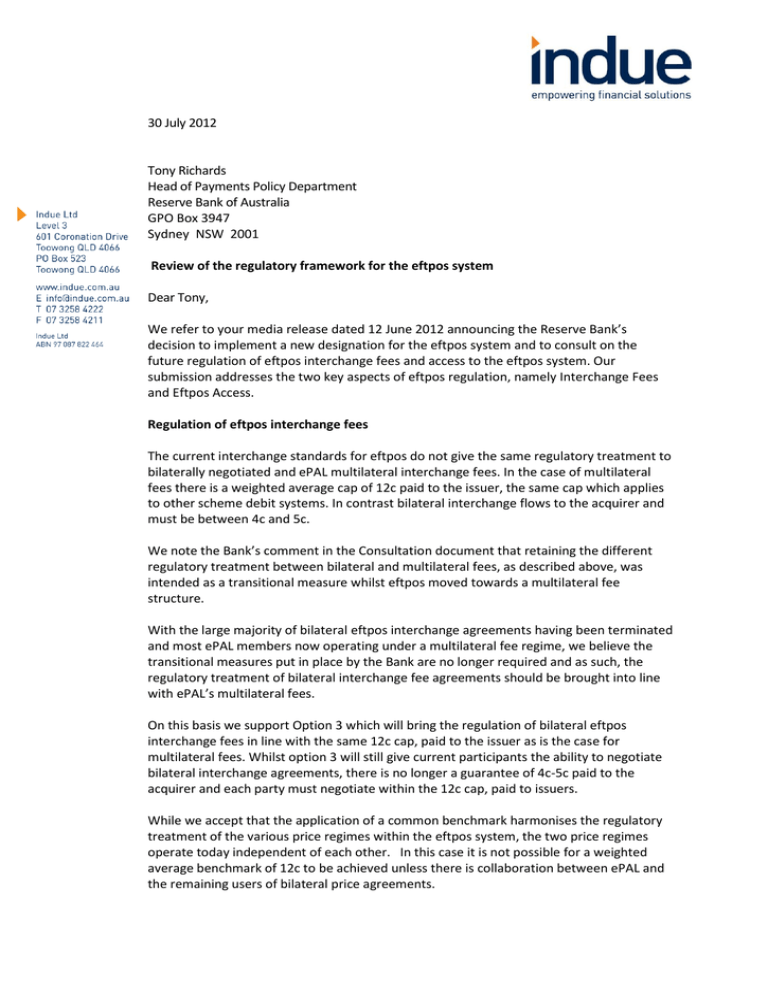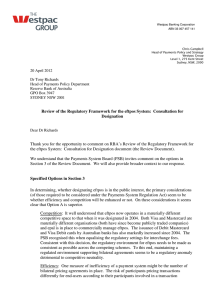30 July 2012 Tony Richards Head of Payments Policy Department
advertisement

30 July 2012 Tony Richards Head of Payments Policy Department Reserve Bank of Australia GPO Box 3947 Sydney NSW 2001 Review of the regulatory framework for the eftpos system Dear Tony, We refer to your media release dated 12 June 2012 announcing the Reserve Bank’s decision to implement a new designation for the eftpos system and to consult on the future regulation of eftpos interchange fees and access to the eftpos system. Our submission addresses the two key aspects of eftpos regulation, namely Interchange Fees and Eftpos Access. Regulation of eftpos interchange fees The current interchange standards for eftpos do not give the same regulatory treatment to bilaterally negotiated and ePAL multilateral interchange fees. In the case of multilateral fees there is a weighted average cap of 12c paid to the issuer, the same cap which applies to other scheme debit systems. In contrast bilateral interchange flows to the acquirer and must be between 4c and 5c. We note the Bank’s comment in the Consultation document that retaining the different regulatory treatment between bilateral and multilateral fees, as described above, was intended as a transitional measure whilst eftpos moved towards a multilateral fee structure. With the large majority of bilateral eftpos interchange agreements having been terminated and most ePAL members now operating under a multilateral fee regime, we believe the transitional measures put in place by the Bank are no longer required and as such, the regulatory treatment of bilateral interchange fee agreements should be brought into line with ePAL’s multilateral fees. On this basis we support Option 3 which will bring the regulation of bilateral eftpos interchange fees in line with the same 12c cap, paid to the issuer as is the case for multilateral fees. Whilst option 3 will still give current participants the ability to negotiate bilateral interchange agreements, there is no longer a guarantee of 4c-5c paid to the acquirer and each party must negotiate within the 12c cap, paid to issuers. While we accept that the application of a common benchmark harmonises the regulatory treatment of the various price regimes within the eftpos system, the two price regimes operate today independent of each other. In this case it is not possible for a weighted average benchmark of 12c to be achieved unless there is collaboration between ePAL and the remaining users of bilateral price agreements. While one would always hope for collaboration between the various parties concerned, in the event that collaboration fails, who practically will arbitrate between the parties to ensure that the benchmark is achieved? At present there is no obvious party who can force all participants to make concessions. We assume that in the absence of any affirming statement in the consultation document, the RBA does not see itself as fulfilling to role. Clearly the fact that the opportunity exists (and acknowledged in the consultation document) for a participant with bargaining power to retain or negotiate bilateral fees agreements more favourable to them than would otherwise apply through the multilateral interchange fee scheduled by ePAL, why would we expect that a participant in this position would be willing to consider the whole of system impact as opposed to expecting ePAL as the scheme administrator to balance the affect of their unique bilateral agreement by making suitable adjustments to the overall multilateral fee schedule? We believe that this is an important point not addressed in the consultation document that allows for some uncertainty to remain in the system which makes administering the payment system problematic. Eftpos Access Access Code In the absence of any centralised governance for the eftpos system, the eftpos Access Code and EFTPOS Access Australia Limited (EAAL) were established and subsequently administered by APCA. With the formation of ePAL, it is now possible for ePAL to take responsibility for granting and managing eftpos connections and therefore removing the need for a separate company to manage the Code. We would expect that if ePAL is given the responsibility of managing access, any impact to a participant of the eftpos system arising from a change in technology or network architecture (e.g. centralised hub) would be communicated and managed centrally by ePAL as the central governing body. On this basis we would support ePAL in the role of managing the Access Code and equally endorse that EAAL be disbanded. Access Regime In terms of the no discrimination provisions contained within the Access Regime, we question the need to retain these given the current situation where most ePAL members have signed up to the multilateral interchange fee structure and our expectation that new entrants will also adopt the ePAL multilateral fees rather than negotiate bilateral agreements. The intent of the provisions were to ensure a new entrant was no worse off than existing participants in terms of interchange, however this is now achieved through the multilateral interchange fees set by ePAL. On this basis we support a move by the Bank to remove the no discrimination provisions. In looking at the reason why the Bank introduced the access charge benchmark, it was primarily because the high costs - charged by incumbents - of establishing a new connection which were making it prohibitive to new entrants. It was on the basis of our own experience in negotiating changes to our clearing and settlement arrangements that we supported the introduction of a benchmark in 2006. We continue to be supportive of retaining the benchmark however we see no reason why the recalculation cannot wait until 2014 given we do not believe the current price is proving a barrier to new entrants. Turning to a separate matter, there is currently an anomaly between the drafting of the eftpos and ATM Access Regimes in terms of the applicable connection costs which should be examined. The ATM Access Regime which was drafted in 2009, three years after the eftpos Access Regime, recognises the rights of direct clearing/settlement arrangements as being separate to those of establishing a direct connection. This is not the case for the eftpos Access Regime which remains silent on this matter. As defined in the ATM Access Code, and referenced in the ATM Access Regime, a direct clearing/settlement arrangement is an arrangement between two parties that are indirectly connected via a Switch that enables them to exchange ATM Transaction messages and, directly clear and settle ATM transactions that arise between them. A participant establishing a direct clearing/settlement arrangement was not subject to the connection cap of $76,700 but rather “no charge may be levied between participants in the ATM system for providing the Direct Clearing/Settlement Service”1. Without the certainty of this same provision in the eftpos Access Regime, participants who choose to conduct their eftpos clearing through a switch will not have the certainty of a nil charge as they do today for ATM clearing. Given the close practical parallels between the clearing and settling processes for both systems, we do not believe eftpos can exist without the same level of certainty as the ATM system with respect to clearing and settling. Thank you for the invitation to discuss our submission with the Bank - we look forward to this opportunity. Should you have any questions about our submission, please feel free to contact me on (07) 3258 4248. Yours sincerely Michael Swannell Executive Manager – Payments 1 RBA AM Access Regime
